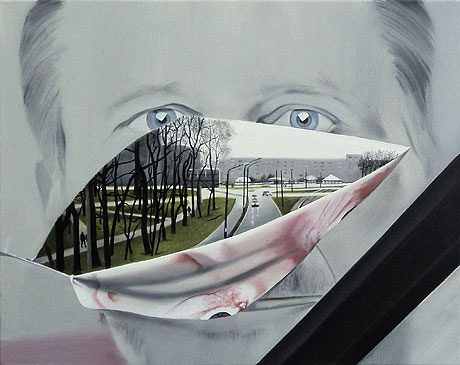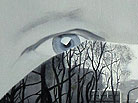Maciej Nawrot — ‘Days go by in a rush like wild horses from a hill’

Pictures by painter/security guard
During the summer holidays of 2009 I decided to work off and on as a security guard. It appeared that my work wasn’t physically exhaustive at all, so I had plenty of spare time to think. So I decided to do something during my long work hours in order to make the work time pass faster. Next time I brought to work an impregnated canvas and oil paints. The professions of security guard and artist painter have one common feature: observation. I have been spending long hours of my service in a sterile tin hut with a wooden desk and a few chairs. I was painting its interior to kill my time. At the same time I worked diligently as a security guard, since thanks to painting I was thoroughly watching the surrounding.
For hours and out of boredom I have been watching black ants which moved in the sink. Sometimes I was watching the naked woman in the diary of June 2002, hanging on one of the empty walls. One day, just before taking my service I saw a worrying burnt-out hole in one of the doors. Of course, I personally reported this fact to the central office. There was a radio on my desk; this made me feel not fully lonely. In a porch I was always leaving the light on, and a wooden handle of the spade in the corner to make me feel safe during the night. I had also a mirror, thanks to which I painted my self-portrait in the balaclava; I seemed to be waiting for the end of my service for an eternity, what was driving me mad.
Maciej Nawrot

‘Inessentials’ — book summary of exhibition cycles The project ‘Inessentials’, which is planned for the whole year, involving artists, designers and the local community in a series of...

Małgorzata Szymankiewicz — ‘Low visibility’ in ‘small space’ En eye should be quick and good. There is no time for raising eyebrows, for closing eyelids – it might be too late. In past times one needed time for a...

Karolina Żyniewicz — ‘Fear of Darkness’ — within the framework of Biennial of Art for Children When Karolina Żyniewicz organises space, she doesn't clearly mark the focal point. The objects are laid out and hung in accordance with her own geometric...

Bartosz Kokosiński — ‘Some pictures do not want to be painted’ Bartosz Kokosiński's most recent paintings look as if something has just wriggled under their surface, stretching the canvas and disfiguring the frames with...

I decided to paint it, says Maciek. We can feel that something can happen within certain selected frames, but we are still not sure whether we are in the right place and on the right time. The only thing that seems to be sure is the fact that spectacular things are already absent. The reality which we can observe with Maciek’s eyes is impossible to be processed and fathomed. The repose is more original than motion in it. No wind is blowing; the fingers are tightly laced; a pinup girl on the calendar sheet from June 2002 is hanging on the wall of the barrack.
Maciek’s pictures are free from anxiety. They act on the same principles as his bait for fish, which he eagerly constructs, composed of little furs, wires and feathers. They seem fragile in an aesthetical balance they have reached for a while. These perfect cuts of reality are firstly drawn from the surrounding with the lens of the mobile phone. Reality in them takes a condensed and squashed form.
His sharpened ways of observation, which are typical for his angling passion, Maciek transfers into ways of painting. He watches his surrounding with similar tenderness like he does with each vibration on the glassy surface of the water during angling. Pictures of gloves return each winter, presented in close-ups on small canvases. They are painted with tact in a way we usually stroke our pets. Sometimes it’s important how the gloves are kept in one’s hand, how they are clutching a handle, in a bag with pretzel, or how they are lying uselessly on the knees. Maciek studies their surface on a bus; he is delighted with hardness of the skin, the little balls resulting from repeated washing, bright colours, and the grade of softness. Gloves without character, faded or black, which impatiently control the surrounding or are nervously taken in the other hand or frayed don’t escape his attention. The possibility of movement is suspended under the tenderly touches of the brush in order to easy our watching.
In the picture the handbag on the woman’s lap is more shiny, and the gloves more fluffy. Very clean loose sand clutched to and arm of a sleeping boy in the blue shirt. Usually, however, courtyards, streets and backstreets remain just as they are, abandoned and squalid. In this lack and absence the peace is sprouting. Maciek is recording the vividness which reveals for a while from the accidental configuration of objects. This includes almost imperceptible settings of the phenomena taken just before they melt. His pictures are recording splinters which have caught his lazy eyes and forced him to look deeper and more intensely. Time and space pressed in this way are developing because of the very pay of attention. They are softening and expanding under our piercing look.
Maciek narrows his eyes and determines the edges of the frame. People appear rarely in his pictures, substituted by a fragment of their figures. He marks his presence only a few times in some camouflaged self-portraits; we can see him in a balaclava, or the top of his head reflected in a mirror. Painting, he looks for a place for himself. He glues himself z from retrieved views and situations like from lacking parts that are scattered around in the gloomy surrounding. There is only what he is looking at.
Marta Lisok
Curator
(Days go by in a rush like wild horses from a hill — the title of Charles Bukowski’s volume of verse of 1969.)








